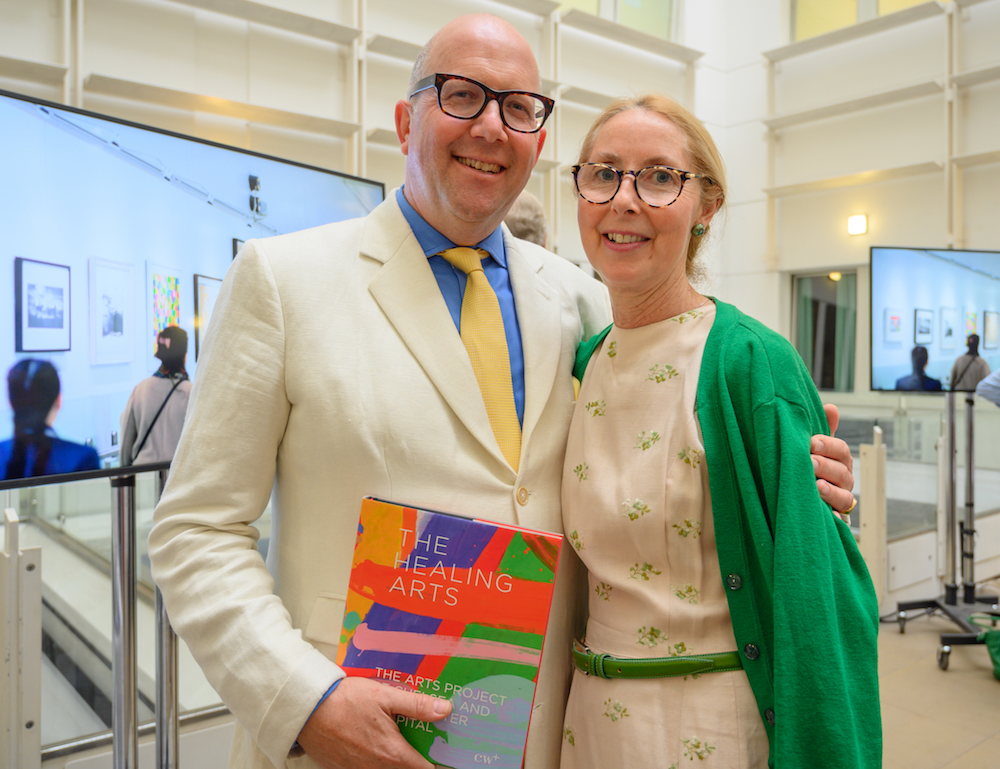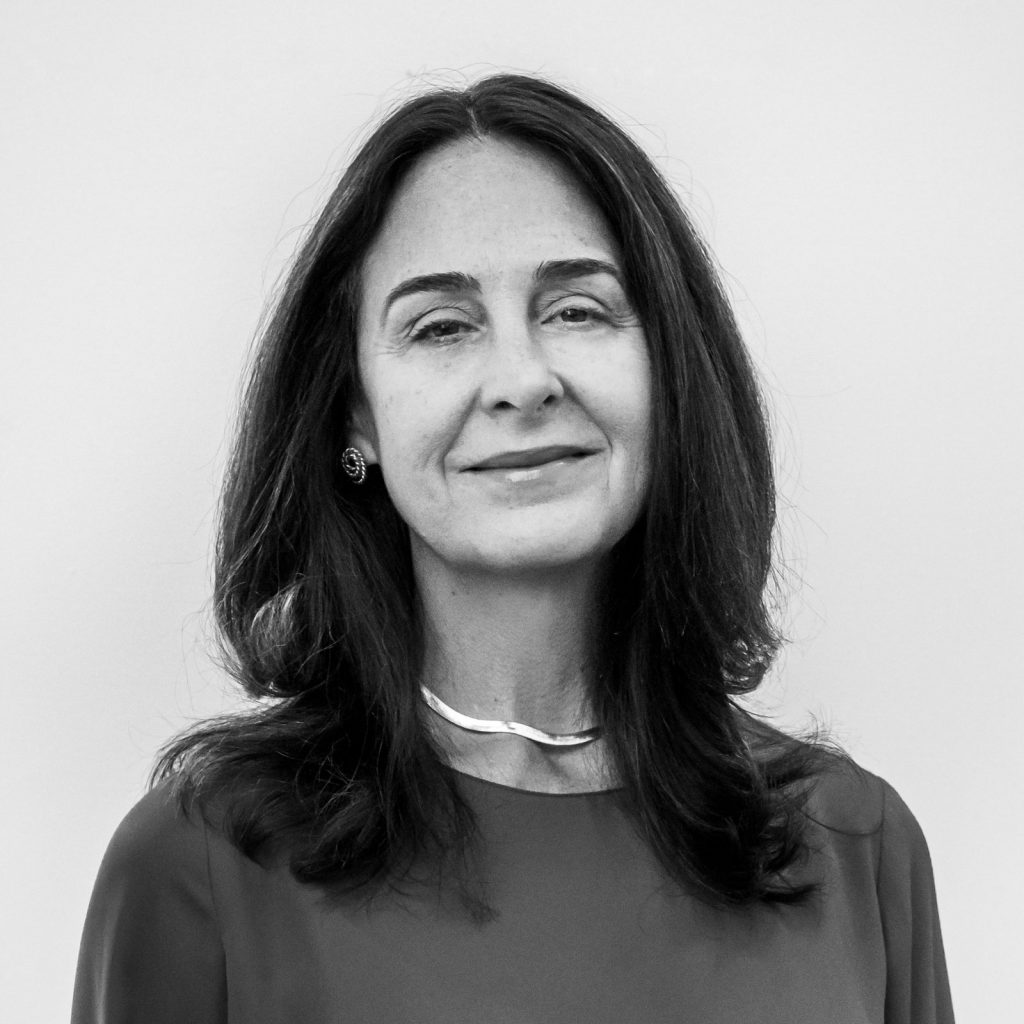In the Deloitte Art & Finance Report 2019, Freya Stewart contributed an article on the current state of the asset-based art-secured lending market, and the challenges and opportunities the next five years will bring.
“Awareness and understanding of art-only asset-based financing among the top-end collecting community and, importantly, their financial advisors and family offices, has without doubt risen in recent years…. In particular, significant younger collectors, and collectors who are entrepreneurs in other markets, are coming to recognize the diverse utility of art-secured credit facilities…
… The growing demand for art-backed loans is a natural reflection and extension of the increasingly sophisticated nature of the world’s most active and prominent art buyers.”
Read Freya’s full article on pages 120 – 121 of the Art & Finance report here.
WHAT MAKES COLLECTING CARS SIMILAR TO OTHER ASSETS?
Like fine art, many collectibles have seen significant appreciation in value over the past decade. This includes classic cars; which collectors purchase because they are passionate about the cars and can enjoy the asset. Unlike a stock or a painting, part of the fun is that the collector can drive a classic car.
Just as with art, the collector should obtain professional advice to choose a classic car wisely. A collector needs to understand the market and ride out the fads and will usually have to keep a classic car for several years before noticing any potential appreciation.
A collector also needs to be aware of the provenance of a car, understanding its history. Has it been well maintained? How many owners has it had? Has it been shown or won awards? If it has been restored, when was it done and by whom?

WHAT ARE THE BIGGEST CHALLENGES TO COLLECTING CARS?
Because of the illiquid nature of classic cars, there are several issues for collectors to consider. For instance, while a stock can be sold rapidly, finding a buyer willing to pay the asking price for a vintage car may take time, and the interest in different makes and models will differ. These longer cycles may not necessarily correspond with the collectors need to convert a classic car into cash.
While hunting for classic cars is exciting, it is important that collectors plan for their collections. A key issue is capital gains taxes. If the cars are appreciating, collectors should talk with a financial advisor or accountant regarding how to minimize the capital gains. Global trends and tastes change so it is important to follow the market and monetize when demand is strong.
Another concern is that vintage car parts may not be readily available. Since finding replacement parts for a rare car may be difficult or expensive, a newer collector may want to choose something not extremely rare.
It also may be difficult to find a good mechanic. The process of diagnosing automotive problems by sound alone is becoming a lost art. Modern mechanics rely on a host of computerized readers to determine what is wrong with an engine, and that equipment does not work with antique and classic cars.
Storage fees are yet another concern. Depending on how many cars a collector owns, special classic car storage facilities may be required.

CAR COLLECTING TRENDS
Factors such as scarcity, brand, age, condition, provenance and desirability can affect the value of a classic car. A supercar may be a high-risk investment, but it could be very lucrative. The most profitable supercars tend to be models that are in development and up for sale prior to delivery.
According to Steve Linden, classic car expert and CEO of Chrome Strategies, the interest in Preservation Class cars, ‘survivor cars,’ continues to grow. These are cars that are in good condition and have not been restored. Collectors face difficult choices in deciding whether to restore classic cars or leave the vehicle in its original state. The best appreciating classic cars are ones that were produced in limited runs and aspirational vehicles even when they were new.
FURTHER READINGS
- Art, Cars & Collectibles: How to Mitigate Risk Before a Disaster Hits
- Market for Sport Memorabilia Continues to Score Big
Whether you are building a wine, art or trading card collection, or determining the best way to sell your tangible assets, there are fundamental steps to follow.
ACQUISITION STRATEGY
Wine is a traditionally popular place to build assets, but trading cards are growing as viable alternative investments. While each must be approached differently, there are similarities in how best to establish your collection.
Charles Curtis is a Master of Wine and founder of WineAlpha, a fine wine advisory serving private, trade and institutional clients with an interest in the market for fine and rare wine.
He advises following these steps:
- Break it into sub-genres: Since what is true for Bordeaux is not necessarily true of Burgundy, you must understand the multi-year trends for each wine type. Slavishly following trends can result in strategic errors.
- Avoid the bubble: Right now, for example, Burgundy is trading at historic highs so finding value is tricky. To do so, know which producers are popular (Domaine de la Romanée Conti), where prices are rising (La Tâche) and where they are stagnant (the bottling from the Romanée Conti itself).
- Protect value: Pay attention to provenance, condition and rarity, factors essential to driving asset value in any category. For instance, there will be tens of thousands of cases of your typical first-growth Bordeaux produced and hundreds of cases of magnums, but only a few dozen to a few score of larger bottles such as double magnums (3 liters), jeroboams (5 liters) or imperials (6 liters).
- Avoid the “unicorn”: While rarity is important, maintain common sense. Certain wines such as Lafleur ’47 and magnums of Petrus ’29 are so rare that they are almost invariably counterfeit. To steer clear of problems, stick with wines that have a solid provenance and trading history.
- Play the arbitrage: Wine is a global category, so to get in at the right price don’t overlook sourcing in London or Hong Kong. Typically, London sales have the lowest prices, while the best property often comes up in Hong Kong (albeit at a premium).
- Pay attention to expenses, but don’t cut corners either: It is essential to use temperature-controlled shipping and storage and to insure wine end-to-end, but it is important not to overpay for these services, or to pay too much tax. As with everything, the devil is in the details.
While wine has long been popular in collecting for investment purposes, building a trading card portfolio is emerging as a very profitable undertaking. Growing interest was stoked by the sale in February 2018 of a 2000 Tom Brady Rookie Card for nearly $110,000 at auction, reflecting an almost 300% return on investment in just two years
Brent Huigens, CEO of PWCC, the largest trading card venue, lays out six essential rules for investing in trading cards:
- Establish a goal: Determine how long investments will be held and the return desired. Consider whether this will be an actively managed portfolio, which may require more time for tracking demand and pricing trends, or one that can be left alone to appreciate.
- Specialize in a sector: A trading card portfolio should revolve around a type of card – new or old, sports or non‐sports, mainstream or esoteric card productions, or from a specific era within vintage or modern cards. Investors can still diversify within a narrowly defined “sector,” and advanced investors might maintain several portfolios, each with a unique focus.
- Personalize to your interests: Consider gravitating toward a sector that resonates with you because the in-depth research and analysis essential to portfolio construction may be more enjoyable. A passion for the investment could separate the most successful investors from the pack; they are often more willing to dig into the industry’s detail.
- Pick a portfolio size: Whether available funds for this venture are $10,000 or $1 million, it is possible to create a well‐diversified portfolio. Clearly, a smaller budget may mean targeting lower-valued cards, but the ROI is as bright on both low and high value cards. Use historical sales tools to study the market, assess historical sales patterns and build future portfolio goals.
- Understand eye appeal: Evaluate the quality. Card values can be complex, relying on a combination of the card, its professional grade and the quality of a card within that grade, which can significantly impact market value.
- Seek professional guidance: Real‐time analytical tools and investment guidance that help develop an investors strategy and help pinpoint the right cards for a portfolio are available from professionals.
SALES STRATEGY
Selling your tangible assets is a very tricky business, so whether it’s just one item or a collection that you hope to sell, professional guidance is absolutely necessary. It’s a big mistake to do it alone if you want the best results. An advisor will make your endeavor effortless and transparent, and most importantly, ensure you get the highest return.
Anita Heriot, President of Pall Mall Art Advisors, uses the term “tangible asset fiduciary” to describe our work on your behalf in the sale process. A tangible asset fiduciary is a “fire wall” between the client and the auction house, dealer or art advisor. We are your representatives, making certain that the sale process works, that the work of art is placed with the best venue, and that all the steps for a successful sale are met.
We start by determining the most appropriate method and market for sale. While some works can and should be sold privately, others benefit from a more competitive market by being sold at auction in a specialized sale.
Several steps are necessary to ensure a good result at auction, and it starts with finding the right auction house. Although most regional and national auction houses have Fine Art Departments, only a select few have specialized sales that target the right collectors for a particular work. These specialized sales include more thematic categories like the annual “Orientalist Sale” at Sotheby’s in London or Copley Fine Art’s bi‐annual “Sporting Sale,” or regional specializations such as Freeman’s bi‐annual Pennsylvania Impressionists sale or Leslie Hindman’s “Made in Chicago” sale.
Using specialized sales is strategic because the auction venue has dedicated marketing and a focused clientele for the specific work to be sold. Even with the full scope and reach of the internet and international bidding, choosing the right brick-and‐mortar venue still can be the difference between a work selling and a work selling well.
To find the right venue and specialized sale for your artwork, our team looks at how many works of art by the artist in question have been sold by each one of several key auction houses we identify.
We utilize this same thought process when assisting with all tangible assets, including furniture, decorative arts and collectibles.
Equally important is negotiating the terms of the sale. The auction business is expense heavy because auction houses must insure the works while in storage, produce expensive catalogues, pay for expensive real estate and pay their expert staff. As a result, they try to look to sellers to absorb some costs by charging fees for photography, insurance, storage, shipping and marketing, as well as a seller’s commission. However, all of these fees can be waived if the collection has value.
Other essential steps include:
- Marketing: Ensure that your work is featured in any press and placed in a predominant place in the catalogue and in the internal auction marketing campaigns. To get a high price at auction people must be aware of your work of art. High exposure is essential.
- Estimates: These are the “secret sauce” to a successful sale. Auctions need a minimum of two people who want your work. Better yet would be 10 or more people bidding online, in the auction room or on the phone. Therefore, it’s best to place estimates that appear to be below the value of the work, giving you a much better chance at a higher return. It may seem illogical, but auction psychology requires emotion.
- Guarantee: For a very significant work of art, you may benefit from establishing an auction guarantee. While not always in your financial interest, it provides a safety net.
- Reserve: Set a reserve, the lowest number at which you are willing to sell your work. While not known to the public, a reserve should be set as close to the sale date as possible because a lot of information comes into the auction house very close to the sale which will provide insight into buyer interest in the piece. Make sure your reserve is low enough that an auctioneer has the ability to start low to get people excited about bidding on the piece.
- Insurance: The biggest losses tend to occur when the artwork is in transit from your house to the auction house. Have a true insurance value on the piece so that in case of loss you are made whole. Don’t trust the shippers to have appropriate insurance.
- Placement: Make sure that when the exhibition is up for viewers of the sale your work is displayed in a dominant position in the sale room and has good light.
Finally, avoid having your work of art go unsold because that’s not good for its resale value. If you carefully follow the steps above, you should have a successful sale and not get the object back.
As you can see, regardless of the object of value, the selling process can be quite complex, which is why it is a mistake to do it alone. Allow a tangible asset fiduciary to bring expertise to the successful sale of your work of art or collection.
FURTHER READINGS
- Is Art a Good Investment?
- Art & Collectibles: the Rise of Alternative Investments
- Protect Your Investments while Divesting Tangible Assets
Henry Little, Associate Director of our art team, is a frequent contributor to Phaidon publications such as Vitamin T: Threads and Textiles in Contemporary Art and most recently, Great Women Artists. Past and present female artists are gaining greater recognition throughout the art world, a shift this comprehensive volume reflects. Featuring more than 400 artists from 50 countries, this fascinating presentation of 500 years of female creativity ‘reveals a parallel yet equally engaging history of art for an age that champions a greater diversity of voices’.
The publication Great Women Artists will be available from 25th September 2019, visit the Phaidon website for more information.

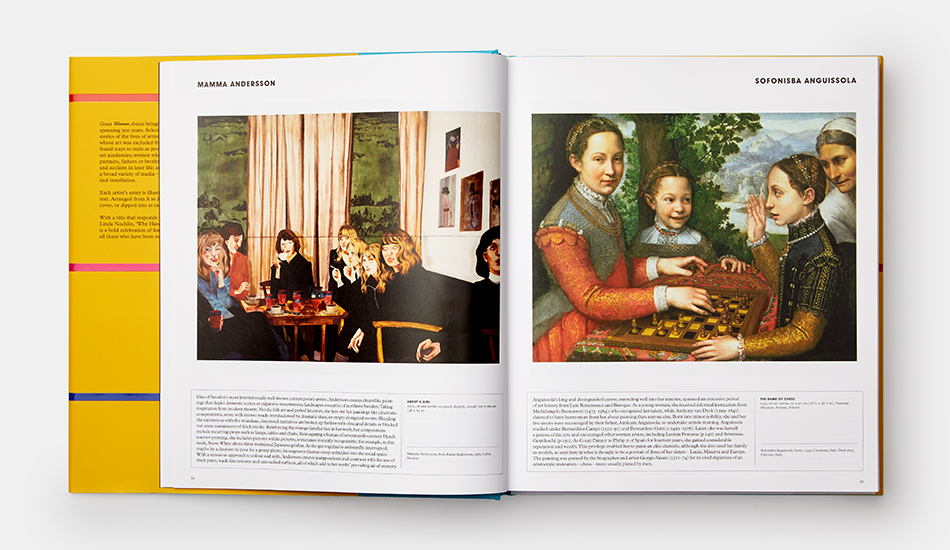
FURTHER READINGS
The Fine Art Group is proud to announce the opening of a new regional office in historic Charleston, S.C., allowing our experienced team of appraisers and advisors to maintain the highest levels of accessibility, transparency and trust for clients in the southeastern United States.
Since its founding in 1670, Charleston has remained a cultural crossroads and retained an extended dialogue with the fine and decorative arts market driving connoisseurship and collecting throughout the region.
TFAG looks forward to taking part in this important conversation by providing clients with the same access to exceptional art market intelligence they have grown to know and expect. Our services include appraisals, visual inventory, collection management, art advisory and continuing education. Details on these services are at our service page.
Shane David Hall, Appraiser & Advisor – Senior Decorative Arts Specialist, will lead the Charleston location. Shane earned Bachelor of Fine Arts degrees in Historic Preservation, Urban Planning and Art History from the College of Charleston, and a Master of Arts in American Fine and Decorative Arts from Sotheby’s Institute of Art, New York City.
With a lifelong enthusiasm for art, architecture and decorative arts, Shane began his career as curatorial assistant at This Historic Charleston Foundation and interned with the prestigious Winter Show. He acquired extensive art market experience at three international auction houses, becoming the Director of Selkirk Auctioneers & Appraisers in St. Louis, Mo. , one of America’s oldest auction firms. Shane is certified in the Uniform Standards of Professional Appraisal Practice and is an active member of the College of Charleston Alumni Association. Hall looks forward to assisting clients in North Carolina, South Carolina, Georgia, Alabama, Mississippi, Louisiana, Texas and beyond.
SHANE’S INSIDER GUIDE TO CHARLESTON
MUSEUMS
Gibbes Museum of Art
Founded in 1858, the Gibbes Museum is the foremost collection of American art that incorporates the story of Charleston and the South. The museum connects the city and regions artistic past to a vibrant contemporary art scene and continued scholarship.
Halsey Institute of Contemporary Art
Housed within the School of the Arts at the College of Charleston, the Halsey originates five to seven exhibitions annually dedicated to contemporary art and focusing on emerging and mid-career artists.
EVENTS
Charleston Antiques Show
The premier fine art and antiques show in the southeast highlighting over 30 dealers of fine arts and antiques showcasing 17th to mid-century modern, English, European and American period furnishings, decorative arts and fine art, architectural elements, garden furniture, vintage jewelry, silver and more.
Spoletto USA
For 17 days and nights each spring, Spoletto Festival USA fills Charleston’s historic theaters, churches and outdoor spaces with performances by renowned and emerging artists in opera; theater; dance; and chamber, symphonic, choral, and jazz music. Spoleto Festival USA is recognized as America’s premier preforming arts festival.
DINING
Breakfast
Miller’s All Day
Celebrating everybody’s favorite meal by shining a spotlight on small batch grains, perfectly turned eggs, delicious proteins, craft cocktails, and gentle surprises designed to delight even the most hardboiled diner.
Lunch
Gaulart & Maliclet
Providing fresh, affordable, healthy, global cuisine with French flair in a social environment that encourages community and the Arts.
Dinner
FIG
Our approach is simple. We have a passion for pure flavor, quality ingredients, and for creating an atmosphere that is convivial, approachable, and a haven for people who simply love food.
THE FINE ART GROUP AT LONDON ART BUSINESS CONFERENCE
On September 4th, Freya Stewart will be speaking at The Art Business Conference.
Now in its 6th edition, The Art Business Conference is an annual one-day conference, held in the heart of London. Through paneled discussions and speeches by leading experts in art, business, and technology, the conference provides an informed global perspective on key issues of the art market, and looks ahead to potential future developments.
Freya Stewart will be speaking on the subject of Demystifying Art Finance in conversation with Financial Times reporter Melanie Gerlis. Their session includes,
“Whether you own your own art collection, are an advisor seeking more insight for clients, or if you just want to know more about this rapidly developing market, this ‘need to know’ expert session will cover the ins and outs of art lending from loan costs and terms to financing for art business.”
Read more about The Art Business Conference here.
WHAT ARE THE “BLUE CHIP” AREAS OF NUMISMATIC COLLECTIONS?
The financial world and the art world effortlessly intersect when it comes to investments in valuable works by “Blue Chip Artists.” “Blue Chip” is a term that originated in finance to describe large and established companies whose stocks have a solid current value and dependable financial future. In the art world, the term has been applied to certain artists who had an established and successful career and predictable, strong and appreciating values for their works on the secondary market. Rothko and Picasso are core examples, where their works are acquired as investments and appreciating tangible assets.
The spotlight is often on significant and recognizable artists of the Modern and Contemporary art market, with both the art world and financial world tracking their sale results and new world records at Sotheby’s and Christies annually. However, quietly and without fanfare, there are incredibly impressive markets for other tangible assets. This includes rare and collectible coins, for which the market of sales and acquisitions surpassed a staggering $4 billion in 2018 alone. Other categories include rare and historical manuscripts, collectible cars and luxury time pieces.
What are the “Blue Chip” areas of numismatic collections? Blue Chip coins, like stocks, are examples that have demonstrated long-term investment security and growth. For coins with numismatic value, which have value surpassing their intrinsic or material value, value is often tied to rarity and grade.

Some of the areas in numismatics which are considered blue chip due to their appeal to serious collectors and a strong and steady value appreciation are the following:
EARLY GOLD
“Early Gold” refers to any gold U.S. coins minted between 1795 and 1839. The first gold coins were introduced in three denominations: the $10 eagle, $5 half eagle and $2.50 quarter eagle. The denominations weren’t printed on the coins, but value was based on its weight, with the $10 eagle being equal to ten silver dollars. These early United States gold coins are coveted by collectors and investors for their historical importance, rarity and value. The most coveted and valuable are high-grade uncirculated examples that can sell into the millions of dollars. One of the most valuable coins in this group is the finest example of the 1795 Draped Bust Gold Eagle which had a mintage of 5,583 coins. However, experts suspect that only 10% of these coins survived. The finest example, part of the D. Brent Pogue Collection, sold for just over $2.5 million in 2015 at Stacks Bowers.
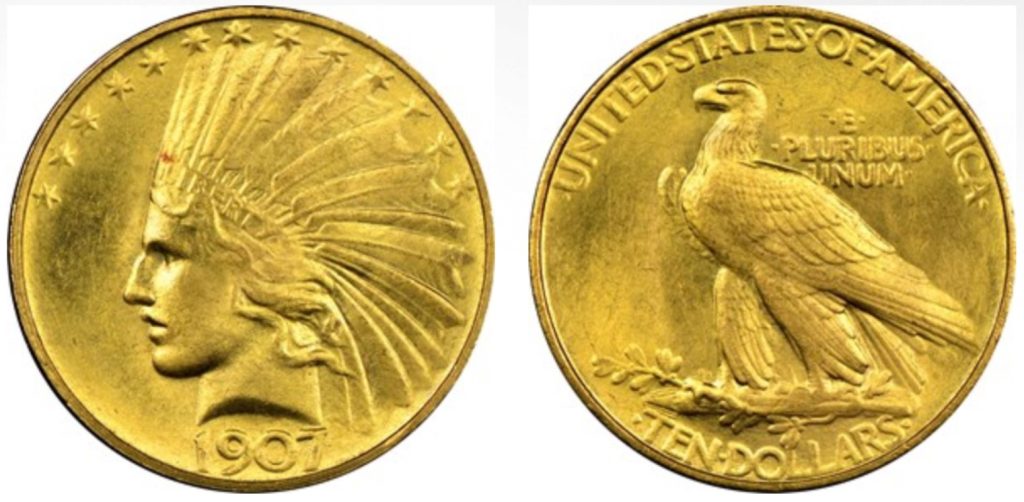
KEY DATES
Coins are produced in certain quantities or mintages each year, with certain dates or particular mint locations being scarcer than others due to only a small number of coins either being minted or a change in production resulting in the original mintage being melted, with only a select few being retained. For U.S. coins, the particular coins produced in a certain year where the mintage or surviving coins is small are referred to as “Key Dates.” These particular coins are some of the rarest in the numismatic world. They tend to sustain and appreciate in value as they are always sought after by serious collectors and investors who have a need to complete a collection. One of the most valuable of these key date coins is 1907 rolled edge Indian $10, which has doubled in value over the last 20 years, consistently selling close to $200,000. The value is due to the original mintage of 31,500 coins being held back before release and melted down. It is suspected under 50 coins were retained for archival purposes.
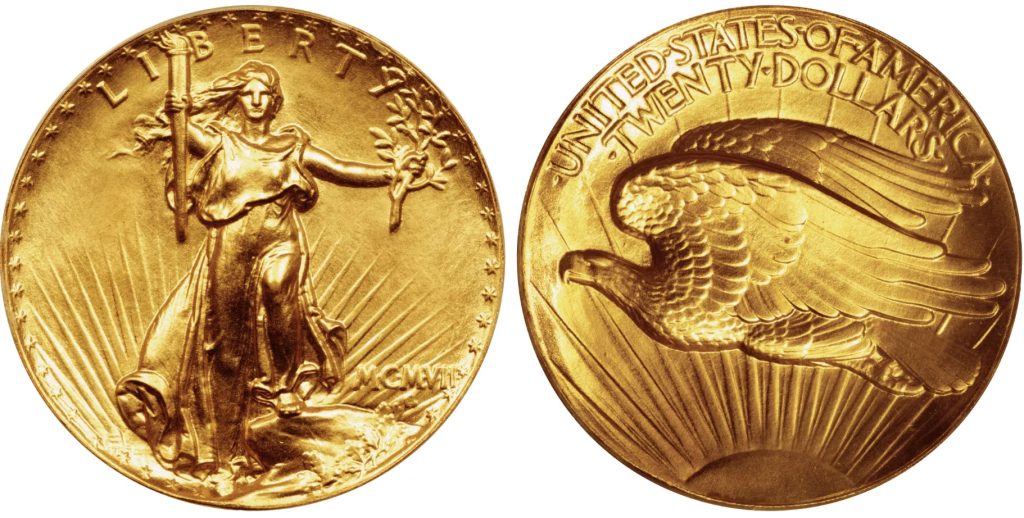
PROOF GOLD COINS
Proof coins are a limited number of coins produced by a mint to check the dies. U.S. mints began producing proof coins in 1820. In some years only 100 proofs were produced. They can be identified by their shiny surfaces and sharp crisp details and edges. Proof coins are rare and valuable, and coveted by collectors. Due to their limited mintage and the steady appetite of new collectors, the values for the early gold proofs has only increased. One of the more valuable proof coins is the 1907 Saint-Gaudens Gold Double Eagle Ultra High Relief. Then President Theodore Roosevelt had ordered the coin to be re-designed where the relief decoration would be much higher than usual. The mint attempted the high relief; however, the process was complicated and ultimately it was deemed not efficient for mass production. The design was eventually lowered, but in the short term a few ultra-high relief proof coins were produced. These proofs consistently sell above $2 million at auction, with the finest examples selling close to $3 million.
Serious numismatic collectors and investors tend to focus on these three collecting areas due to the significant rarity and the long-term investment that goes with that. With a fixed and limited supply of these early minted coins and demand ever increasing, the investment opportunity is solid and established.
FURTHER READING
- Insider Look at Fine Art, Wine & Trading Cards
- Art & Collectibles: The Rise of Alternative Investments
THE STATE OF THE ART MARKET: SPRING 2019
2018 was a very busy year for both auction houses and the private sector, with global art market sales reaching $67.4 billion up 6% year-on-year.[1] Auction houses and larger galleries are prospering in this market, leaving smaller and mid-sized galleries behind and increasing the disparity between these large and small organizations. Fewer galleries are opening and more are closing as bigger gallery names consolidate both artists and clients.[2] Museums and dealers alike are focusing their attention on diversity and inclusion, highlighting artists of color and women who are experiencing increased exposure in exhibitions leading to an increase in market demand. 2018 was a record year in terms of sales volume and Postwar and Contemporary art remained the leader, followed by Impressionist and Modern. [3]
The art market is not protected from uncertainty and functions like other big markets. In 2016, all major markets declined due to economic and political uncertainties damaging market confidence, with sales losing 16% of their value in the years 2014 to 2016.[4] By 2017, the environment of the market improved for sales with stronger consumer confidence and increased supply at the top of the market. The market realized a powerful and positive gain of 12% in 2017 with the auction sector outperforming the dealer sector. While the mood of the art market in 2018 was slightly less hopeful due to larger economic and political issues impacting investor and consumer attitudes, it did not stop people from buying. More risk-averse buyers and sellers moved into private sales within the dealer market, which experienced a 7% growth in 2018. The auction market advanced by 3%, and there was additional e-commerce growth. [5]
The majority of growth at auction continued to be focused on the top end of the market, leaving the middle and lower segments to be stagnant or declining, a trend reflected in the dealer market as well. In 2018, sales in the auction segment (including both public and private sales auction houses, both on- and offline) constituted 46% of the market, down 1% year-on-year. The dealer segment (including dealer, gallery, and online-only retail sales) made up the remaining 54% of the market.[6] Sales at public auction of fine and decorative art and antiques (excluding auction house private sales) reached $29.1 billion in 2018, an increase of 3% year-on-year, and up nearly 30% over 2016; dealer sales in 2018 reached an estimated $35.9 billion, up 7% year-on-year.[7] The global art market continues to be dominated by the US, UK and China, with their combined sales accounting for 84% of the global market’s total value.
The art world continues to be globalized, bringing in more success for auction houses and larger galleries alike, impacted greatly by technology. Increased integration between technology and the art world has led to a greater flow of information globally, allowing buyers to access images and information on works instantly. Technology is actively influencing how buyers are making decisions and is even going so far as to impact art-making with AI. This has led to the increased importance of online sales; in 2018, global sales in the online art and antiques market reached an estimated $6 billion, up 11% year-on-year.[8]
In 2018, art fairs continued to be a crucial aspect of global art sales and act as a central part of the livelihoods of many dealers. There were around 300 fairs with an international element in 2018, and art fair sales were estimated to have reached $16.5 billion in 2018, a rise of 6% year-on-year. [9]
Over the past decade, sales have generally reached a much higher level making it increasingly hard to establish and maintain continued high levels of growth, especially when coupled with a supply-limited art market. The volume of sales as measured by the number of transactions increased at a slower rate compared to values, growing only 2% year-on-year. The number of transactions reached its highest level since 2008 at an estimated 39.8 million, led primarily by increased sales by dealers in the online sector with fine art auction declining slightly for the second consecutive year. [10]
SEGMENT TRENDS
Contemporary art continues to dominate with booming sales and growth across the board.[11]
Post-War and Contemporary art was the largest sector of the fine art auction market in 2018, accounting for 50% by value and 47% by volume. Reaching sales of $7.2 billion, Post-War and Contemporary art realized an increase of 16% year-on-year, despite a minimal drop in the number of lots sold by 5%.[12] Currently, the Contemporary market is experiencing a big push for both artists of color and female artists. These underrepresented groups are gaining more attention, and specifically there is a growing interest in abstract expressionist female painters. In 2018 the US remained the global center for Post-War and Contemporary art. Looking East, China maintained its spot in second place. The growing Asian market for Post-War and Contemporary art recently has focused on younger, contemporary artists such as Banksy, Kaws, and Jonas Woods. Furthermore, globally, there has been a revival of interest in established artists from the 1960s and 1970s, with more inclusion of female artists and artists of color. Following another strong year of growth in 2018, the value of Post-War and Contemporary art increased by 63% in the past decade from 2008 to 2018.
After Contemporary sales are Impressionist and Modern sales. Behind the Contemporary sector, in 2018 the Modern art sector was the second largest in the global fine art market with a share of 29% by value and 31% by volume. Following two years of strong growth, in 2018 Modern art sales were $4.3 billion despite a decline of 10% in the volume of transactions. [13] Demand for Picasso paintings from the 1960s is as high as ever, as is interest in key members of the Surrealist group, in particular René Magritte and Joan Miro. Behind Modern art is the Impressionist and Post-Impressionist market, a sector which has had mixed performance over the past decade. The sector had a share by value at 15% in 2018, a slight decrease from 17% in 2017. The Impressionist and Post-Impressionist sector constituted 14% of the share in the number of global fine art lots sold at auction.[14]
The smallest of all the sectors in the global art market is Older Master and European Old Masters. Accounting for 6% share of the value of the fine art auction market in 2018 (down 3% from 2017), Old Masters made up 8% of the number of transactions in the fine art auction market. In 2018, the sales of all Old Masters works fell right below $905 million, a 31% decline in value year-on-year. This decline can be partially attributed to the outlier lot in 2017. The sector’s market has declined over the last 10 years, with values at their lowest point after falling 9% since 2008.
FURTHER READING
- State of the Art Market: Insights Into the Spring 2022 Auction Season
- Looking Forward: Ten Art Market Predictions for 2023
- Spring Art Market Recap 2022
Bickar, Betsy. State of the Art Market: Spring 2019. Report no. Spring 2019. April 17, 2019. Accessed July 23, 2019. https://www.privatebank.citibank.com/pdf/State-of-the-Art-Market-Spring-2019.pdf.
McAndrew, Clare, Dr. The Art Market 2019. Report no. 3. Accessed July 23, 2019. https://www.ubs.com/global/en/about_ubs/art/2019/art-basel.html.
[1] McAndrew, Clare, Dr. The Art Market 2019. Report no. 3. Accessed July 23, 2019. https://www.ubs.com/global/en/about_ubs/art/2019/art-basel.html.
[2] Bickar, Betsy. State of the Art Market: Spring 2019. Report no. Spring 2019. April 17, 2019. Accessed July 23, 2019. https://www.privatebank.citibank.com/pdf/State-of-the-Art-Market-Spring-2019.pdf.
[3] Ibid.
[4] McAndrew, The Art Market 2019. Report no. 3.
[5] Ibid.
[6] Ibid.
[7] Ibid.
[8] Ibid.
[9] Ibid.
[10] Ibid.
[11] Bickar, State of the Art Market: Spring 2019. Report no. Spring 2019.
[12] McAndrew, The Art Market 2019. Report no. 3.
[13] Ibid.
[14] Ibid.
NEW PUBLIC SCULPTURE UNVEILED OF CHARLES DARWIN
ON THE WEST SQUARE OF THE TAIKOO HUI DEVELOPMENT, PART OF SWIRE PROPERTIES
On Thursday 27th June, Phillip King unveiled a new sculpture, named after the celebrated biologist Charles Darwin, at its permanent home in China.
The Fine Art Group advisory team worked closely with the commissioner Swire Properties, the artist, and Thomas Dane Gallery on this exceptional commission. We are delighted to be involved in such an important piece of public sculpture, the second work by the artist in China.
Phillip King said at the unveiling, “My feeling on coming here to witness the unveiling of my work, Darwin, 2019, is mostly one of humility at the honour of being perhaps one of the few British artists who will have a public work in this great historic city.”
King, who like Darwin graduated from Christ’s College Cambridge, based the sculpture on Darwin’s impact, through science and history, on the world today and how he helped us see the world in a new way.
THE SCULPTURE’S MEANING
The composition consists of four interrelated elements. The man himself is found in the dynamically raised triangle, positioned on a tilting slope to represent the unknown world. The circle is placed on the corner of the slope symbolising the known world. These elements are separate from a fourth, a square gate through which both living and non-living entities are able to reach the “Great Unknown”. King explains that he included an angled panel in the doorway as a reminder that the entrance is only partially open.
King goes on to explain that he was not consciously of this symbolism when he worked on the Darwin project. The elements “reflect how the eye connects to the brain through a king of developing filter of past memories and acquired conceptions, for example, the use of the triangle, the circle, and the square which go back to the beginning of my sculptural concerns in the early sixties.”

ABOUT THE ARTIST
Phillip King is a British sculptor, born in Tunis in 1934. He studied Modern Languages at Christ’s College, Cambridge from 1954–57, and sculpture at Central Saint Martins College of Art and Design, London, from 1957–58; where he was a favourite pupil of Anthony Caro. Following his studies, King spent a year working as an assistant to Henry Moore and teaching at Central Saint Martins College of Art and Design, London. King lives and works in London.
SELECTED PUBLIC COLLECTIONS
Arts Council of Great Britain
British Council, London, UK
Calouste Gulbenkian Foundation, Lisbon, Portugal
City of Rotterdam, Netherlands
Contemporary Arts Society, London, UK
Cultural Centre, Adelaide, Australia
Government Art Collection, London, UK
Hakone Open Air Museum, Japan
Hiroshima Museum of Contemporary Art, Japan
Musée National d’Art Moderne, Centre Georges Pompidou, Paris, France
National Gallery of Victoria, Melbourne, Australia
National Museum of Art, Osaka, Japan
New Museum of Contemporary Art, Hiroshima, Japan
Prefectural Museum of Contemporary Art, Toyama, Japan
Rijksmuseum, Netherlands
Scottish National Gallery of Modern Art, Edinburgh, UK
Stuyvesant Foundation, New York, USA
Tate Gallery, London, UK
Tel Aviv Museum, Israel
Yale Centre for British Art, USA
RECENT SELECTED SOLO SHOWS
2018 Luhring Augustine Gallery, New York NY
2017 Thomas Dane Gallery, London, England and Galerie Lelong, Paris, France
2015 Kistefos Museet, Norway
2014 Thomas Dane Gallery, Ranelagh Gardens, and Duveen Galleries, Tate Britain, all London, England
2013 Consortium in Dijon, France
2012 Speerstra Foundation, Apples
2011 Flowers Cork Street, London
2008 Bernard Jacobson Gallery, London
2007 Bernard Jacobson Gallery, London
2006 Bernard Jacobson Gallery, London
2003 Jesus College, Cambridge
2002 Place Gallery, Cavagnole, Italy
2001 Bernard Jacobson Gallery, London and Garth Clark Gallery, New York
PROFESSORSHIP
St Martin’s School of Art, London, England 1959-1980
Hochschule der Künste, Berlin, Germany 1979–1980
Professor Emeritus, Royal College of Art, London, England 1980-1990
Professor of Sculpture, Royal Academy Schools, London, England, 1990-1999
President of the Royal Academy, London, England 1999-2004
OUR SERVICES
Offering expert Advisory across sectors, our dedicated Advisory and Sales Agency teams combine strategic insight with transparent advice to guide our clients seamlessly through the market. We always welcome the opportunity to discuss our strategies and services in depth.
ART & INNOVATION AT CHELSEA & WESTMINSTER HOSPITAL
We are delighted to have sponsored The Healing Arts, a collection of essays delving into the story of the arts and Chelsea and Westminster Hospital, from the pioneering arts and design programme to the hospital’s impressive art collection.
Spearheaded by the team at the hospital’s charity CW+ the innovative art and design programme combines live performance, workshops and technology to transform the hospital environment for the patients, their families and staff.
Trystan Hawkins, CW+ Arts Director, commented: “The Healing Arts celebrates the legacy of the arts programme founders at Chelsea and Westminster Hospital, demonstrating how their vision allows us to continue to innovate by commissioning ambitious, bold and daring contemporary art and design that has profoundly positive impacts on patients, staff and visitors. We are incredibly grateful to our community of supporters, who make our work possible.”

The hospital’s art collection is funded, curated and managed by CW+ and has over 2,000 artworks, including a Veronese in the hospital chapel and monumental Allen Jones in the atrium. The fact that many of the donations come from local artists, such as Patrick Heron, Mary Fedden and Eduardo Palozzi, cements the collections position in the community.
Philip Hoffman, our CEO and a member of the CW+ Development Board says “Art serves many purposes, often to communicate, to emote, to create a sense of beauty or to motivate; but within the walls of Chelsea and Westminster Hospital it plays another vital role. Art goes above and beyond, and instead becomes a tool for healing.”
Read more about CW+’s incredible work and The Healing Arts here.
